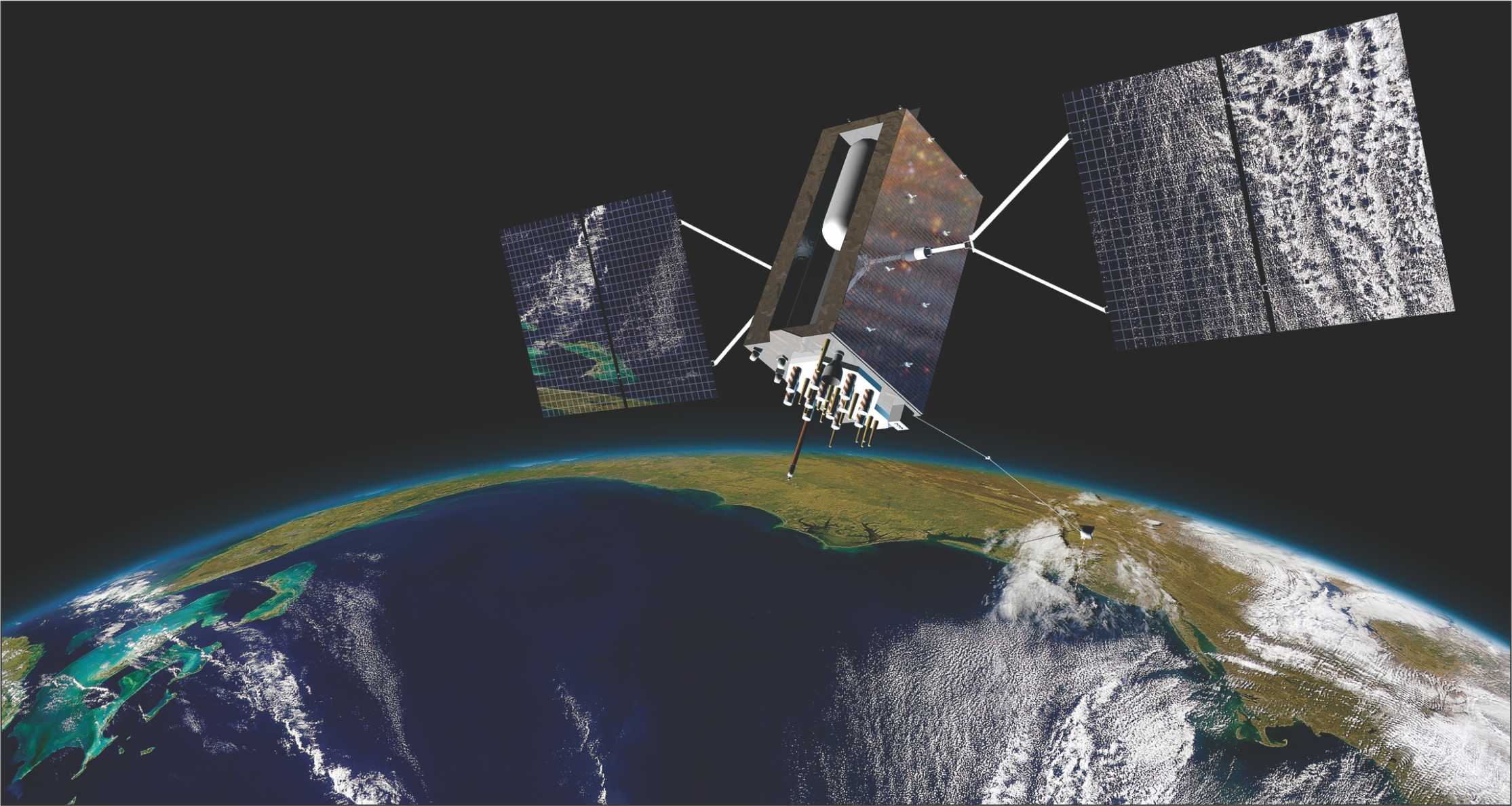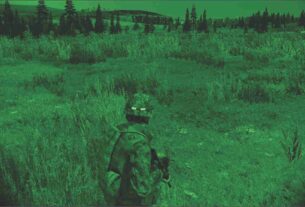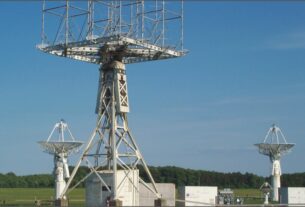For more than a decade now, the passionately deliberated proposal for the creation of a tri service Indian aerospace command, has been in the limelight with the eight decades plus old Indian Air Force (IAF) stridently articulating the need for such a formidable military structure fully well supported by a string satellites meant for a variety of end uses. But unfortunately the ruling dispensation in New Delhi seems to be totally indifferent and insensitive to the long pending issue of giving green signal for the realization of the aerospace command.
Of course, much hope was pinned on the Narendra Modi led NDA (National Democratic Alliance) Government, which has left none in doubt about its commitment to the cause of strengthening the defence set up of the country, in so far as getting a green signal for the formation of the aerospace command was concerned.
But here again the initial momentum that the Modi Government had displayed with reference to freeing the Indian defence establishment from the curse of dithering, policy paralysis and supreme unconcern-the hall mark of the two successive UPA (United Progressive Alliance) regimes that ruled India-seems to be dissipating as rapidly as it manifested. It is the tragedy of the Indian defence set up that things never move on time when it comes to equipping the defence forces with serious consequence for the national security apparatus.
The ruling elite in New Delhi should realize that the creation of a tri service aerospace command that could give IAF a new edge to face the threat from nuclear powered China and Pakistan- in a two front war- is the crying need of the hour. To cut the long story short, the need for the creation of an aerospace command is now and here and the Indian Government can ignore this issue at the risk of imperilling the national security in all its manifestations.
Of course, there is no denying the point that the creation of an aerospace command would necessitate a massive investment and acquisition of many technologies and systems that are difficult to source from within the country. But then on account of these factors alone India cannot simply afford to postpone or ignore the creation of a tri service aerospace command that would make for an enhanced situational awareness to monitor the threats emanating from diverse directions and a variety of sources. In the ultimate analysis, a continually evolving Indian tri service aerospace command fully supported by space based platforms could help keep a constant surveillance on the machinations of the forces inimical to the country.
Key objectives
On its part, Indian defence set up has already made a detailed study of issues concerning the setting up of an aerospace command with particular reference to the aerospace commands operating in other countries including USA and Canada. Ensuring free access to space while denying the adversary the advantage of using space platforms in the event of a war could be one of the key goals of the Indian aerospace command. Other well identified goals of the proposed Indian aerospace command would include giving out missile launch warnings and monitoring the launch of satellites by the adversaries. Quick mobility and strategic strike capability with a vastly enhanced reach are the other positive factors that the Indian defence set up can look forward to from a well endowed aerospace command.
The biggest disadvantage in terms of acquiring satellite assets that the Indian aerospace command would need is the failure to create a national infrastructure resurgent enough to build and launch a large number of satellites on a short notice and with a short turn around time. For since most of the defence satellites on account of their positioning in low earth orbital slots have invariably short lifespan, thereby implying the need for a constant replacement and replenishment.
On another front, availability of a solitary space port in the form of Satish Dhawan Space Centre(SDSC) in Sriharikota island on India’s eastern coast which could support just 4-5 orbital missions a year could prove to be a big handicap for the proposed Indian aerospace command in terms of replenishing the space assets on a sustained basis. As such the need for a second launch centre has become all the more pronounced. Of course, the Indian Space Research Organisation (ISRO) has hinted at identifying suitable site for the setting up of a second full fledged launch centre. It makes for immense strategic sense to operate two launch centres. Incidentally, China which already operates three landlocked launch centre, is now close to commissioning an ultra modern coastal launch centre at Wenchang in Hainan island.
Of course, the high level of expertise that ISRO has already built up in the area of designing and developing a range of state of the art satellites for a wide ranging applications including communications, remote sensing, weather watch and navigation could be a big plus point for the Indian tri service aerospace command. But the catch is that with its limited infrastructure and human resources, ISRO will not be in a position to meet the space resources needs of the Indian aerospace command. As such, the immediate priority should be on creating an industrial base in the country that would be robust enough to deliver satellites and launch vehicles in a ready to use condition and well on time.
Boosting capabilities
Along with the satellites, which serve as “ears”, “eyes” and “command posts” in outer space the missile defence shield being put in place by the Defence Research and Development Organisation( DRDO) could boost the defensive and offensive capabilities of the aerospace command. Equally important to the successful operationalization of the Indian aerospace command is the capability for network centric warfare based on a well endowed C4ISR system. While the C4 components of the system-computer, command as well as communications and control-constitute the back end, ISR (intelligence, surveillance and reconnaissance) made up of orbital, airborne , maritime as well as fixed and mobile ground based sensor system constitute the front end to help find ,fix and track hostile targets and evaluate the damage to the potential enemy targets.
According to IAF Chief, Arup Raha, dynamism and flexibility are the tenets of airpower and these are exactly the attributes that proposed aerospace command would bring in abundant measures. IAF is continuously enhancing its capabilities across the entire spectrum of operational requirements with the aerospace command still in the realm of possibility. But then orbiting satellites stand out as the vital sinew of the proposed aerospace command.
As a follow up to the August 2013 launch of India’s first ever dedicated military satellite GSAT-7 meant for the exclusive use of the Indian navy, it is planned to orbit GSAT-7A as the dedicated IAF satellite for linking up India’s airborne early warning and control system aircraft with each other as well as ground and air based radars. The Defence Space Vision 2020 document of IAF outlines the need to harness satellite resources in a big way to augment the Indian defence capabilities. According to this document, IAF has identified outer space as an area of intense focus to sustain India’s strategic lead.
As it is, an advanced satcom system like GSAT-7A could be widely used by military commanders for two way communications with forward echelons which can help improve the tactical battlefield decision making process and boost the capability to carry out surveillance and reconnaissance without let or hindrance. Dedicated military satellites are capable of storing and transferring information including video data to multiple military units spread across a vast geographical swath. Significantly, this type of synergy is critical for the coordination of disparate forces operating from various parts of the world. Satellite based communications, surveillance of the vulnerable spots of adversaries and navigation as well as precision targeting all go to serve as a force multiplier by a substantial extent. Combination of space assets and conventional military capabilities helps eliminate prospects of surprise and in turn helps deter the opponents from going in for a conventional battlefield strategy. It is taken for granted that for meeting their strategic communications needs all the three wings of services would use both fixed and mobile satellite systems. Easy to operate and highly mobile satcom terminals come in handy when the topography to be negotiated is inhospitable and difficult to access, GSAT-6 high power S-band communication satellite launched by the orbital mission of the three stage, Mark Two version of the Geosynchronous Satellite Launch Vehicle( GSLV) could be a big asset for the Indian aerospace command. The capability of GSAT-6 could be used by the Indian defence forces for two way, strategic communications to help stay at the winning edge of the battlefield. In particular, armed forces operating in remote, difficult to reach geographical stretches would be able to establish communications links with hand held terminals by making use of the GSAT-6 potential.
This satellite featuring many innovative technological elements will allow Indian defence forces to communicate rapidly and reliably with a view to get a clear, real time picture of the battlefield space. The cuboid shaped GSAT-6 with a lift off weight of 2200-kg is equipped with a digital multi media broadcasting capability featuring the first of its kind large un-furlable S-band antenna with a diameter of six metres. This feature will come in handy for the Indian defence forces keen on getting information in a reliable, secure manner and on a real time basis. The digital compression technique featured by GSAT-6 makes for its vastly enhanced data carrying capability. The advantageous aspect of GSAT-6-is that it can easily exploit the frequency reuse scheme to increase frequency spectrum utilisation efficiency.
The capability of GSAT-6 for two way transmission of voice, video and data in a secure mode fits in well with the strategic communications philosophy of the Indian defence forces The potentials of GSAT-6 can also be harnessed for boosting the rapid strike capability of defence forces through the timely acquisition of relevant information. Further, for the defence forces operating in remote and difficult to reach areas, GSAT-6 would enable establishing a hassle free communications link.
Space assets
Another vital space asset that the Indian aerospace command could count on to sustain its operational efficiency is the home grown Indian Regional Navigation Satellite System (IRNSS),which is an independent space based navigation system on the lines of American GPS, Russian Glonass, European Galileo and Chinese Beidou. It is designed to provide two types of services-Standard Positioning Service (SPS) made available to all the users and Restricted Service which is an encrypted service provided only to the authorised users. Four of the seven satellites constituting IRNSS constellation are already in orbit providing services on a regular basis. IRNSS, a dual use system with a large civilian application component, is no doubt an invaluable asset for the Indian defence forces. The strategic advantage of owning and operating a full fledged satellite navigation system hardly need to be emphasized specially during the hours of crisis.
For the Indian defence forces, the uninterrupted access to GPS capability of IRNSS constellation will be an invaluable tactical tool in terms of launching high precision weapons including long range missiles with a high degree of precision. Dedicated navigation satellites have become an indispensable support base for the aircraft, warships and ground forces to get a head start in the battlefield and derive tremendous tactical advantages.
Over the last two decades, the importance of a space based GPS system in determining the outcome in the battlefield strategy has been proved beyond any shadow of doubt. A home grown GPS system like IRNSS could serve as a strategic asset of tremendous significance especially during wartime to counter the possibility of international navigation satellite operators denying access to the Indian defence forces. In this context, the difficulties India had in accessing the restricted services of the American GPS system highlights the importance of a home grown navigation spacecraft system.
For long, the Indian defence forces did feel thoroughly disadvantaged by the non availability of accurate signals from GPS system on a sustained and uninterrupted basis. Indeed, as strategic analysts point out, proper navigation in an unfamiliar territory that is devoid of any identifiable landmarks is vital for the successful accomplishment of reconnaissance missions and well planned military operations. Significantly, to a large extent, the success of Desert Storm military campaign launched in early 1990s by the US led coalition forces to free Kuwait from the clutches of Iraq was a tribute to the imaginative use of space based navigation platforms.
Satellite based navigation, has over the years become an indispensable tool for a variety of civilian and military applications. During India’s 1999 Kargil conflict with Pakistan, Indian patrols operating in the rugged and difficult to negotiate terrain along the lines of control initially strayed into the enemy held territory with disastrous consequences. However, the subsequent availability of hand held GPS receivers proved to be invaluable for the special task forces and crack teams engaged in identifying targets and destroying enemy installations. Indeed the Indian defence establishment has learnt that the inputs provided by the GPS devices could be exploited to coordinate the movement of troops and supply with a high degree of efficiency.
In military scenario, the potential targets need to be constantly tracked before they are flagged as hostile and engaged by various weapons systems and it is here that GPS system assumes significance. The GPS in tandem with GIS allows military planners view, plan, interpret and visualize data in ways that reveal solution and intelligence as never before. As it is, most of the combat aircraft now come equipped with GPS gadgets not only for guiding the flight of the aircraft under the cover of darkness, haze and cloud but also to use weapons and ammunition with a vastly enhanced efficiency.
GPS system particularly designed for weapons delivery stand to benefit from the optimal integration of GPS receivers with inertial measurement units and use of adaptive processing algorithms and antennae that reject unwanted signal interference while enhancing the power of the desired satellite signal. GPS space platforms along with a string of other satellites meant for different end uses hold the key for a well-coordinated and synchronised operation of a battlefield strategy to seamlessly integrate weapon systems, missiles, radars and sensor suits, UAVs, UCAVs, electronics and communications network, fighter jets, transport aircraft, logistics and support systems and defence forces spread across a vast geographical swath for sustaining strategic superiority at all stages of operation.
Way back in 2003, while advocating the need for an aerospace command, the then IAF chief S Krishnaswamy had noted, “Any country on the fringe of space technology like India has to work towards such a command as advanced countries are already moving towards laser weapons platforms and killer satellites in space”. As it is, the integrated space cell set up in 2008 meant to oversee the security of space assets and their utilisation for strategic purposes in addition to effectively using the Indian space assets for military purposes could be the nucleus for the formation of the Indian aerospace command. The aerospace directorate operating from Thiruvananthapuram could make a significant contribution to the formation of tri service aerospace command.
For the IAF, which will be at the forefront of the formation of the aerospace command, the biggest challenge would be how to boost its multi-dimensional surveillance capability essential to get ready to fight a credible two front war. The assets and resources already under the command of all the three services could be harnessed to put in place the architecture of the aerospace command. But then its setting up is a continuous, dynamic and steady process that takes into account the emergence of new technologies and combat systems. An aerospace command ably supported by ground based systems and space platforms of varying description could help keep constant surveillance on the machinations and manoeuvres of forces inimical to the country.
Some of the key objectives of the Indian aerospace command would include enhancing situational awareness in all its manifestations, realizing a home grown platform for the seamless integration of the capabilities of all the three wings of services and ensure free and unhindered access to space while denying the adversaries the opportunity to harness the potential of outer space for staying at the winning edge of the war. The excellent track record that ISRO has already built up in the area of designing and developing state of the art space platforms for applications such as navigation, communications, earth observation and weather watch could come in handy in so far as space component of the aerospace command is concerned.
Strategic superiority
By all means, for the yet to be realized aerospace command, an uninterrupted access to a dedicated constellation of military satellites is critically important to sustain its strategic superiority through the concept of ”see, reach, hit and protect”. Invariably, space capabilities hold the key for the successful utilisation of the network centric system meant to integrate the resources of all the three wings of the services.
The clamour for the setting up of an Indian tri service aerospace command assumed a serious dimension in the wake of the early 2007 anti satellite test by China. For India’s national security apparatus, a robust and well equipped aerospace command was projected as a formidable shield arm against the military misadventure by the two nuclear neighbours.
Needless to say, the proposed tri service Indian aerospace command would need a large and independent GPS capability that could be accessed any time to boost the combat superiority. Clearly and apparently, satcom offer terrain and environmental independent communications platforms. The need for redundancy underpins the deployment of a range of satellites. Defence satellites should have an in built mechanism to automatically and rapidly recover from signal blockages due to man made objects, terrain conditions including towering mountain ranges, foliage, weather and associated environmental features.
On its part, DRDO has come out with a perspective plan to launch a range of dedicated satellites meant for the exclusive use of the three wings of services and the potentials of these satellites can be harnessed to support the proposed tri service aerospace command. At the end of the day, the Indian aerospace command could serve as a military bulwark to blunt the edge of the emerging multi dimensional security threat. And looking beyond the issue of security threat, India in keeping with its status as an emerging technological power, should showcase its military muscle encasing the technological prowess that is immune to the threat of technology denial regime. Only a well equipped aerospace command supported by a range of advanced technology satellites could help India tackle the emerging strategic challenges and security threats with courage and confidence. Of course, India has the expertise, infrastructure and technology to create the nucleus of the proposed tri service aerospace command.
The stunning success with which then US led allied forces were able to pull off their intervention in Iraq and Afghanistan has highlighted the vital importance of the space based assets in realizing the strategic goals in a cost effective and timely manner. Meteorological satellites forecasting weather for facilitating bombing raids and missile launches ,navigation satellites guiding lethal weapons to designated targets, reconnaissance satellites locating the position of military targets, electronic ferret satellites gathering data on radar frequencies, communications satellites providing real time secure links between defence forces scattered over a vast geographical stretch for a coordinated strategy as well as ocean watch satellites snooping on the naval movement of adversaries have all become a puppet in the string of the modern day warfare.
Space capability also constitutes a key element of the network centric system to integrate the resources of all the three wings of the services. In the ultimate analysis, the success of the aerospace command depends on the smartness with which the information super highways and communications channels are exploited for real time coordination of the “strategic moves” of the defence forces spread across a vast geographical swath.
Further, with an increasing number of smart weapons including missiles rapidly becoming autonomous, they would need to be controlled and manipulated through a network enabled command and control structure supported by a constellation of satellites. The mandate of the Indian aerospace command would include air sovereignty and air defence.
For IAF considered the fourth largest airpower in the world, an aerospace command will help it transform into a transcontinental military power endowed with quick mobility and expanding reach supported by force projection. Indeed the aerospace command would help IAF realize its motto of “Touch the sky with Glory”. The clearance of the Rs 8,000 crore proposal in September this year of IAF’s Integrated Air Command and Control System (IACCS) project could help give the Indian aerospace command a head start.





